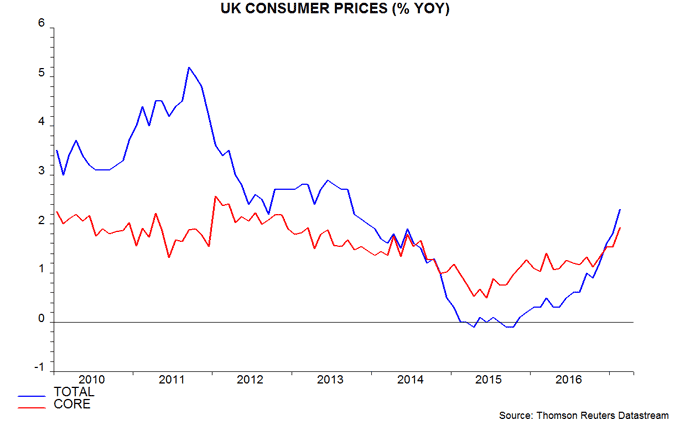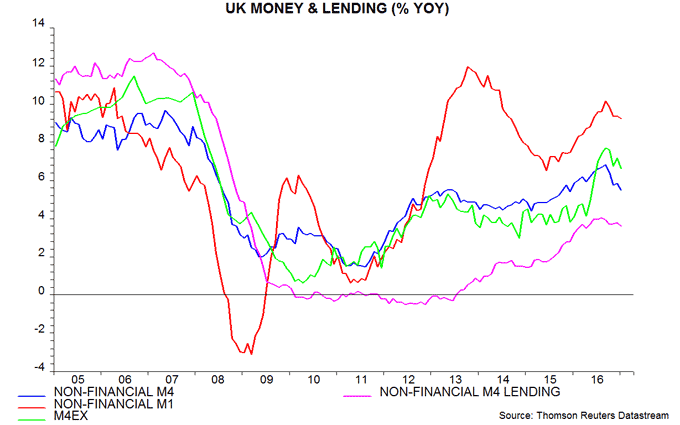UK inflation rise due to loose money not Brexit
A post in October 2016 forecast that UK CPI inflation would rise above 3% in 2017, exceeding Monetary Policy Committee (MPC) and consensus projections. This was based on “core” inflation moving up to about 2.5% by late 2017 and higher sterling commodity prices lifting the headline / core gap to over 1 percentage point*. February numbers released yesterday are consistent with this forecast: core inflation rose to 1.9%, the highest since 2012, and the headline / core gap to 0.4 – see first chart.
The MPC argues that the inflation rise is a temporary consequence of sterling weakness caused by the Brexit vote. A “monetarist” view, by contrast, is that inflation is climbing in lagged response to a significant pick-up in monetary growth between 2011 and 2016. Annual broad money expansion, as measured by non-financial M4, rose from below 2% in 2011 to nearly 7% late last year – second chart. A post in May 2016 showed that similar upswings in monetary growth historically were followed by a sustained rise in core inflation. The post suggested that core inflation would be on an upward trend from late 2016.
The weaker exchange rate, on this view, is part of the “transmission mechanism” from faster money growth to higher inflation, rather than being a primary driver. It is plausible that sterling would be significantly higher if the Brexit referendum had resulted in a “remain” vote. In that case, however, the economy would probably be much stronger – a post in December 2016 suggested that GDP would have grown at an annualised rate of about 3.5% during the second half of 2016 rather than the currently-estimated 2.6%. Greater upward pressure on domestic costs and margins, therefore, would have counterbalanced a smaller import price boost. (The annual rate of change of the GDP deflator, a measure of domestically-generated inflation, rose to 2.8% in the fourth quarter of 2016, an eight-year high.)
The monetarist view implies that the inflation rise will be a level shift rather than a temporary “blip”. Annual non-financial M4 growth has retreated from a peak of 6.8% in September 2016 to 5.5% in January but remains elevated by the standards of recent years. The analysis in the May 2016 post found a two- to three-year average lead from money growth to core inflation, suggesting that upward pressure on the latter will persist through late 2018, at least.
Current broad money growth, admittedly, remains modest relative to the 1980s, 1990s and 2000s – non-financial M4 rose by 9.0% per annum (pa) on average over the 30 years to end-2009. The velocity of circulation of non-financial M4, however, fell by an average of 2.9% pa over this period**. Negative real deposit interest rates have reduced the demand for broad money, resulting in velocity stabilising since 2009. Sustained money growth at its current 5.5% pace, therefore, would suggest a similar rate of expansion of nominal GDP. With potential economic growth generally estimated to be 1.5-2.0% pa currently, such a rate of increase would be incompatible with the 2% inflation target***.
The monetarist view implies that the MPC should have raised interest rates last year as money growth was rising strongly, rather than easing policy in a panic reaction to the Brexit vote. The Committee may choose to reverse the August cut over coming months as inflation exceeds its forecast but is likely to continue to claim falsely that the pick-up is a temporary and unavoidable consequence of Brexit and does not require a fundamental policy rethink. A reasonable assessment is that the MPC has, in effect, shifted from inflation- to unemployment-targeting: the latest Inflation Report, after all, projects that the jobless rate will remain stable at close to its current level through 2020 even as inflation heads for a sustained overshoot.
*”Core” = CPI excluding energy, food, alcohol, tobacco and education adjusted for VAT changes.
**Velocity definition incorporates six-quarter lag on money stock.
***2017 potential growth estimates: OBR 1.9%, IMF 1.8%, EU Commission 1.6%, OECD 1.5%.

Reader Comments